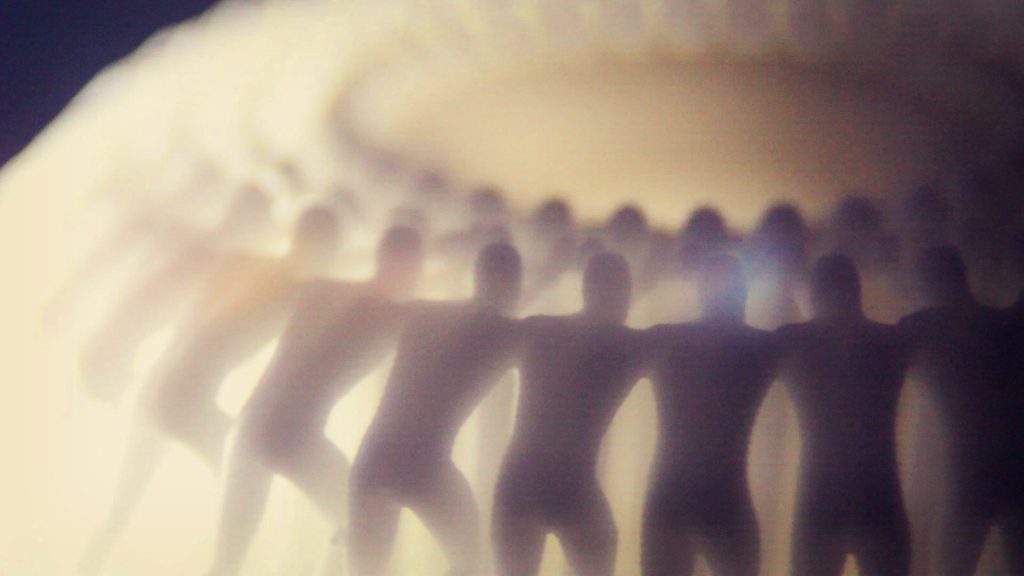In an effort to prove his theory on persistence of vision to a wider, non-scientific audience, Joseph Plateau developed his first phenakistiscope (1832) depicting a dancer who performs a pirouette in 16 distinct steps, each of them separated by a slot in the disc. Although his theory of visual latency as the cornerstone of moving image perception has since been refuted (Anderson & Anderson, 1993), the concept of the frame was born. Ironically, in the perception of the phenakistiscope, the viewer has an ‘omniscient’ perspective on the animation as a whole, thus problematizing the notion of the frame as an impenetrable unit. From this angle, it is relevant to approach the idiosyncratic underlying principles of this apparatus from a perspective of artistic research.
In this practice-based essay, I argue that the phenakistiscope is not an obsolete or primitive moving image device, but a distinct form of animation with its own affordances, as put forward by authors such as Crafton (2011) and Veras (2022). The underlying blueprint of this apparatus remediates remarkably well to contemporary media, from GIFs and video to animated installations and VR. As such, it succeeds in challenging the barriers of the contemporary notion of the frame and the orthodoxy of the screen. Exploring a range of alternative modalities in moving image perception by combining 19th century optical toys with contemporary technology, my artistic research led to a series of works on the verge of animation and installation. Materiality is crucial to this process of ‘slicing’ and resynthesizing, the alchemy of transforming matter into animated time.
What first triggered my artistic research interest is the way in which the phenakistiscope questions our common sense understanding of motion perception, somewhat equivalent to Zeno’s paradox of the arrow, simultaneously moving and stationary. Contrary to the digital moving image, it is not a succession of still images, but a single rotating object, momentarily frozen in time, originally through a slotted disk or prismatic mirror that functions as a shutter. In contemporary remediations, this role is often outsourced to a strobe light or camera synchronized with the rotation, as in the works of Toshio Iwai, Gregory Barsamian, Eric Dyer, or Marie Paccou.
As a result, the perceptual experience is not limited to a single frame, every stage of the sequence is simultaneously visible. In this respect, it is problematic to even use the term ‘frame,’ as hardware and software converge, image and apparatus are joined as one in a singular, circular object (Dulac & Gaudreault, 2004). Each segment, as determined by the number of slots on the disc, can contain multiple images, arranged in concentric circles or on a spiral. Relative to the complexity of the animation, an imbalance arises between the strict playback time — a single rotation — and the time needed to fully grasp the animation on a perceptual level. From this perspective, the phenakistiscope is more than just loop based. Looping is the only possible playback modality to make sense of this form of animation.

From an artistic perspective, this aspect of the immanent loop offers both limitations and opportunities. An animation of a single object or character along a circle rapidly ceases to enchant. Maximizing the complexity of the animation also leads to a heightened discrepancy between playback and reception time. An intricate interplay between multiple animations drifting in opposite directions by adding less or more images, as determined by the number of segments, creates a captivating and hypnotizing encounter. Especially when materialized as a physical object, first spinning incomprehensibly and then gradually ‘falling into place,’ a magic visual experience emerges as inanimate matter suddenly becomes intelligible, and appears to be infused with a breath of life.
The unity between image and signal carrier creates a singular universe that is essential in this experience. When adding a third dimension through 3D printing, the horizontal plane of the zoetrope and vertical plane of the phenakistiscope are being combined, which results in a hybrid between both. This opens up to a more embodied paradigm of spectatorship, inviting the audience to engage physically with the work and be the director of their own visual attention. As such, the phenakistiscope has come full circle — which is, of course, not an end, but just a new beginning.

References
Anderson, Barbara and Joseph Anderson. “The Myth of Persistence of Vision Revisited” Journal of Film and Video, Spring 1993, Vol. 45, No. 1 (Spring 1993), pp. 3-12.
Bolter, J. David, and Richard A. Grusin. Remediation: Understanding New Media. MIT Press, 1999.
Crafton, Donald. “The Veiled Genealogies of Animation and Cinema.” Animation, vol. 6, no. 2, July 2011, pp. 93–110. DOI.org (Crossref), https://doi.org/10.1177/1746847711404979.
Dulac, Nicolas, and Andre Gaudreault. “Heads or Tails: The Emergence of a New Cultural Series, from the Phenakisticope to the Cinematograph.” InVisible Culture, Oct. 2004. DOI.org (Crossref), https://doi.org/10.47761/494a02f6.b2544b15.
Veras, Christine. “Reanimating the History and the Forgotten Characteristics of the Zoetrope.” Animation, vol. 17, no. 1, Mar. 2022, pp. 26–48. SAGE Journals, https://doi.org/10.1177/17468477221085412.
Guido Devadder is a visual artist based in Leuven, Belgium, and teaches at the Department of Audiovisual Arts of LUCA School of Arts in Brussels. He is currently working on a PhD in the Arts at KU Leuven/LUCA School of Arts titled From Post-cinema to Pre-cinema and Back: A Media Archaeology of Loop Animation. A fascination for the idiosyncrasies of obsolete visual media and abandoned modalities of creating and perceiving moving images is at the core of his research. Combining old and new, his work explores materiality in contemporary moving image art. His work was screened, exhibited and published internationally.

